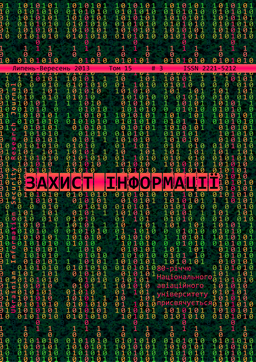Modes of protection of video data from unauthorized access
DOI:
https://doi.org/10.18372/2410-7840.15.4853Keywords:
video data, the protection of video data, unauthorized access, video encoding, data encryption methods to protect the video dataAbstract
The paper reviews existing methods of protection of video. A consequence of the mass distribution of video technology has become illegal copying and viewing of video data - a problem of protection of video. In particular, video data can be distributed to copyright infringement (piracy), and these may refer unauthorized competitors or hackers to obtain sensitive information (espionage). The simplest approach to the protection of video data - is die use of classical encryption schemes open or secret key. Image data file is encrypted and then transmitted over the insecure communications channel or recorded on unprotected media. This method provides a very high degree of protection of video data is achieved by a high resistance used for protection cipher. Often, however, the amount of encrypted data over the text and audio data even considerably more, which requires significant computing resources to such encryption of data. This tends to limit the possibility of using classical encryption in areas such as interactive and cable TV. Users of these services should have a powerful system capable of realtime, without delays decoding, and then decode the received data. Since the main standard used to encode and compress video data format is MPEG, then most of the methods of protection designed specifically for this format. They use features and coding structure of MPEG to reduce the computational resources to protect the video data. One way to protect the first data in the MPEG algorithm was permutation «zigzag». Its essence consists in reading the quantized coefficients of discrete cosine transform method is not «zigzag» for subsequent encoding as defined format, randomly. Different methods of protection vidiodannyh applied to telecommunications systems real-time.
References
Алферов А.А, Зубков А.Ю, Кузьмин А.С. Основы криптографии. — М: Гелиос АРВ, 2001.
Володин А.А. Митько В.Г, Е.Н. Спинько Е.Н. Обработка видео в системах телевизионного на-блюдения // Вопросы защиты информации. — М.: 2002. С. 34-47.
Рябова Л.В, Голембиевская Ю.Г. Базовые операторы для обработки изображений радужной оболочки глаза // Наука і молодь: 36. наук. пр. — К.: НАУ, 2006. - Вип.6 — С. 45-48.
Chung-Ping Wu and С.-С. Jay Kuo. Efficient Multimedia Encryption via Entropy Codec Design. In Proceedings of SPIE, Security and Watermarking of Multimedia Contents III, volume 4314, San Jose, CA, USA, 2001.
C.W. Richardo Identification of three dimensional
using Fourier descriptor objects of the boundary curve. IEEE vol. SMC- 4, Jule 1994.
Alferov A.A., Zubkov A.YU., Kuzmin A.S. Cryptography, M.:Gelios ARB, 2001.
Volodin A.A., Mitko Y.G., Sprnko E.N. Video processing systems, video surveillance, Information security, M.: 2002. pp.3 I 17.
Ryabova L.V., Golembievskaya YU.G. Basic operators for image processing iris, Nauka і molod, K, NAU, 2006, №6. pp. 45-48.
Chung-Ping Wu and C.-C. Jay Kuo. Efficient Multimedia Encryption via Entropy Codec Design. In Proceedings of SPIE, Security and Watermarking of Multimedia Contents III, volume 4314, San Jose, CA, USA, 2001.
C.W. Richardo Identification of three dimensional using Fourier descriptor objects of the boundary curve. IEEE vol. SMC- 4, Jule 1994.
Downloads
Issue
Section
License
Authors who publish with this journal agree to the following terms:- Authors retain copyright and grant the journal right of first publication with the work simultaneously licensed under a Creative Commons Attribution License that allows others to share the work with an acknowledgement of the work's authorship and initial publication in this journal.
- Authors are able to enter into separate, additional contractual arrangements for the non-exclusive distribution of the journal's published version of the work (e.g., post it to an institutional repository or publish it in a book), with an acknowledgement of its initial publication in this journal.
- Authors are permitted and encouraged to post their work online (e.g., in institutional repositories or on their website) prior to and during the submission process, as it can lead to productive exchanges, as well as earlier and greater citation of published work (See The Effect of Open Access).

